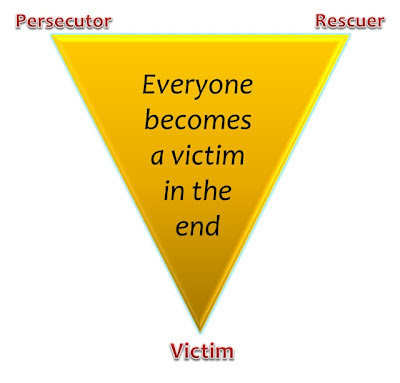Beware The Codependency/Drama Triangle
The figure below refers to what has become variously known as the Codependent Triangle:

There are three main players or roles in this dysfunctional family system ( or any codependent relationship system or group), the Victim, the Persecutor, and the Rescuer. Let's talk a little about each:
Victim--The Victim is characterized by feelings of helplessness, self-pity, and blames others for their problems. In an family with an addict, this is the addict. Victims are characterized by a lot of "poor me" and black-and-white thinking. You will hear them say such things as, " Why do I always get into trouble? Why am I always the blame? Everyone is against me. Nobody likes me. Everybody hates me...." The irony is that everyone in such a dysfunctional system feels the "victim". All of them feel disempowered. Children and teens often take this role.
Rescuer--Here we come to the dysfunctional role played by many parents. Also referred to as an "enabler", these are the martyrs of the system, they are the sufferers. They discount their own needs, always "sacrificing" for the other two players, especially the Victim. They use guilt to control others, avoid their own true feelings, and are usually overstressed.
Persecutor--Finally, we come to the persecutor. S/he abuses others in the system, also uses guilt to control, as well as withdrawal and sulking, and often also uses drugs and alcohol.
Several other points need to be made about the codependent triangle:
All are codependent.
All feel a lack of personal power.
In a family system of more than three, you can have multiple of each of the three players.
This is a dynamic system. There is a lot of switching around of roles. The Rescuer can quickly take on a Persecutor role or a Victim role, etc. Players may switch roles even in a short conversation or interaction.
Personal boundaries are unclear between the players. For example, The Victim tries to get others in the Triangle to be responsible or rescue them. The Rescuer thinks s/he is responsible for the Victim. The Persecutor blames everyone else. There is no clear sense of where each begins and ends, i.e. boundaries.
Each of the players tries to use the others to make them feel like a whole, complete person. But, of course, it or they never do. They always feels something is missing, that they are not complete
The enmeshed family
Such families are also referred to "enmeshed" in family system's theory. That is, they are all tangled up with each other with unclear personal boundaries.
Teens and codependent parenting
With my teens I find codependency often characterizes their relationships or family system. The teen or child is the Victim or Persecutor (especially when they turn teens). Their parents are always rescuing them, not letting and making them be responsible for their behaviors and actions. The parents try to intervene when the teen screws up and keep him or her from having to deal with the consequences of their behaviors.
Toward co-interdependence
Healing requires that the members learn to be co-interdependent. By this I mean they each become whole, complete individuals that depend on each other appropriately and respect personal boundaries.
The Rescuer needs to learn how to take care of his or herself and help the others to learn how to take care of themselves--not try to do it for them.
The Persecutor and Victim have to learn to be accountable, not blame others for their own shortcomings, and take care of themselves-- in short to take responsibility for their own lives and behaviors.
In this way they can depend on each other, and not be codependent, but rather be co-interdependent.



No comments:
Post a Comment